Salcedo's artistic journey
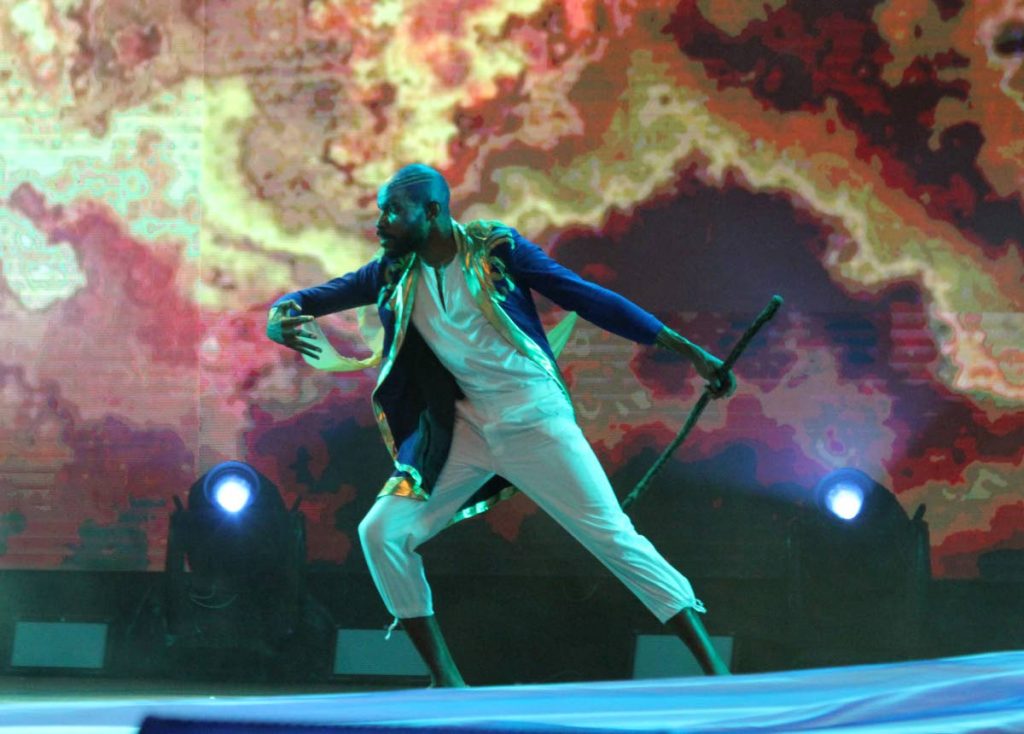
SOMETIMES it takes quitting your job, losing yourself and bumming around to help you find your path. That seemed to be true for Nickolai Salcedo, an actor, singer and visual artist who appeared to be everywhere at the Caribbean Festival of Arts (Carifesta).
He was the lead performer at the opening ceremony on August 16. Two pieces of his artwork were on display at ThinkArtWork Studio. His band played at rock night for the Elemental Series at Big Black Box. He was a voice actor in Kyle Hernandez’s radio play Aron, and five films he acted in were screened in the TT Film Fest.
Newsday met an exhausted Salcedo on September 4 at his art studio and home in Petit Valley. Mongolian throat singing was playing in the background. He said it helped him expand his singing techniques.
Salcedo, 38, is married to Dahlia Fernandes. Since he was a child, he’s been painting, yet that is the artistic expression he says he is least known for. He studied art at the University of the West Indies (UWI), and did a minor in theatre studies, but dropped it, as there were too many other subjects he’s interested in, such as calypso studies.
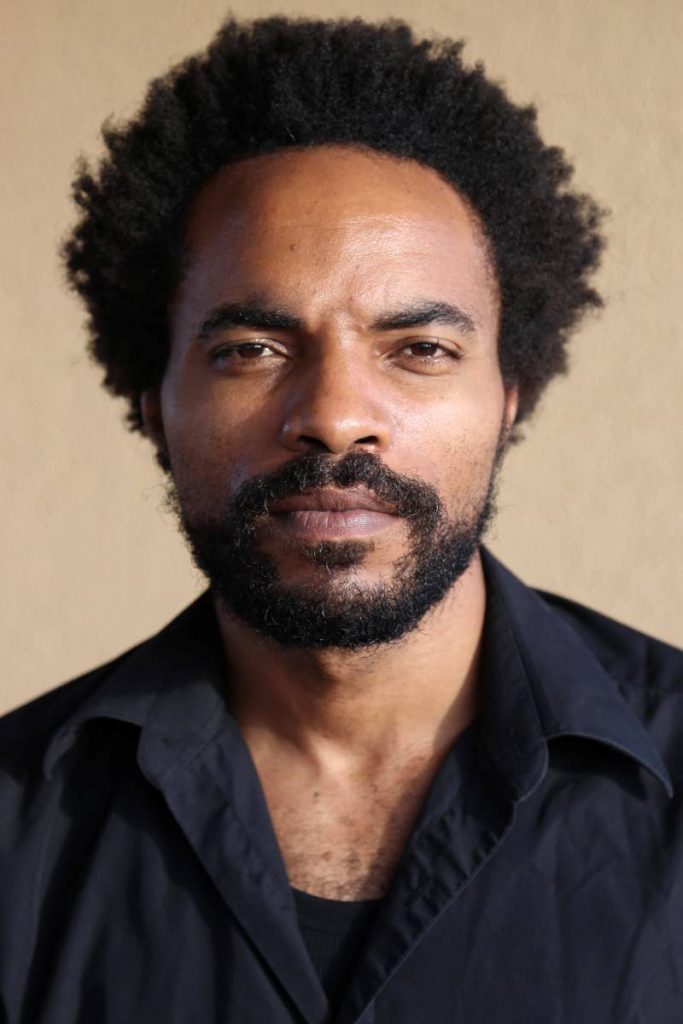
After graduating, Salcedo got a teaching job at Couva East Secondary School, and stayed there for six years. He was playing with his band Gyazette, going home at 3 am, only to leave again at 5.30 am to beat Petit Valley traffic to get to school on time. That exhaustion and lack of enthusiasm drove him to quit his job to stay home.
“I never liked the job. I was struggling to do that. I really just had to quit. I quit in 2010, and between 2010 and 2012 I was just playing with my band Gyazette in the night...whenever occasionally I got gigs.
"Other than that, I was going to the beach and bumming around.”
No one in his life was pleased with his decision.
“All the teachers in my school, they were like, 'What’s going on, buddy? You quit a proper job to do what?'
“The good thing was, where they thought that I was going downhill – and yeah, there were times when finances were so tight I thought I was going downhill too – but I was just enjoying not having to wake up, go to work and not have to slug it out for someone else. I was just happy to just be free to be creative and write a song for whatever I wanted to do.”
After two years he connected with Timmia Hearn, then assistant artistic director of the Trinidad Theatre Workshop (TTW), who offered him a salaried job as an in-house actor.
“She said, ‘I’m starting up an in-house acting company and I would like you to come and try out for it because I think you would be good at acting.’
"I said ‘Eh, I got my band, and theatre isn’t really the thing I want to do,’ but she said come, and I went and she was like: ‘Okay, you’re good, I would like you to come work with us, you get a salary.’”
He worked on productions such as A Midsummer Night’s Dream and Fool for Love.
Falling into film
In 2013 he shaved off his dreadlocks, and offers of acting roles started flowing in. His first experience in film acting was the docudrama Pan! Our Music Odyssey, written by Kim Johnson.
“I didn’t understand what film acting was about. People were like, 'You just have to be smaller, you just have to be small.'”
Salcedo explained: on stage, in front of an audience of 200-500 people, he would have to act for the person at the back of the room.
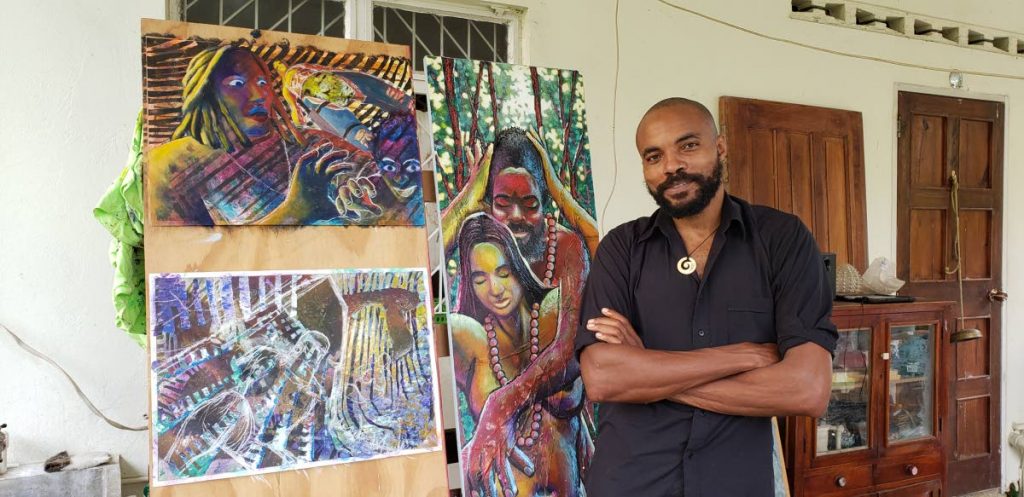
“With film, the camera is right on you. Sometimes it is only on your eyes. You have to put all of your expressions, everything, into just a very tiny box. Any move you make in film, depending on how the camera is, too, can sometimes be read as over-exaggerated and not natural at all. A slight twitch of the eyebrow could show anger or show whatever emotion you want. It’s more internal. With film acting it’s what you’re thinking, not what you’re showing.”
After Pan, he auditioned for the lead of Francis Solomon’s Hero: Inspired by the Extraordinary Life and Times of Mr Ulric Cross. Cross was a TT lawyer and judge who had been a navigator in the Royal Air Force and one of the most decorated heroes of World War II.
“Hero was an on-the-ground workshopping process of acting for me. I would wake up every morning and watch Michael Caine – he has a YouTube video of him doing a workshop.”
To shoot Hero, he travelled to England and Ghana, and that changed his perspective on his life and career.
“I had that epiphany in Ghana: to go back to Trinidad and pretend to be an actor. I told myself, 'This is what you are now. Reinvent yourself.' It has just been constant reinventions.”
Since 2016 he has appeared in a number of movies, among them Play the Devil, Moko Jumbie, Salty Dog, Moving Parts, Battledream Chronicles: A New Beginning, Grace and Saleem, Sampson’s Heart and The Lies We Tell.
Grace and Saleem and Sampson’s Heart won People’s Choice awards at this year’s TTFF Awards for best feature and best short respectively.
Who is the captain of this ship?
Salcedo started Gyazette in 2007. It was his way, he says, to address systemic inequality, criminality, romanticisation of criminality, inequality, normalisation of inequality and injustice. Songs such as Captain, Jumbie and Little Millionaire address these issues. He was inspired by his students: he thought there should be something socially conscious for them to relate to.
“I felt like it’s one thing for adults to internalise and listen to music or lyrics that are vulgar, but it's another thing to watch teenagers talk, dance and seriously internalise vulgarity as normal and part of their reactions with each other. Watching young fellas talk to girls in a certain way, watching the girls internalise certain terminologies referred to them as acceptable. Those things were like, blowing my brain.”
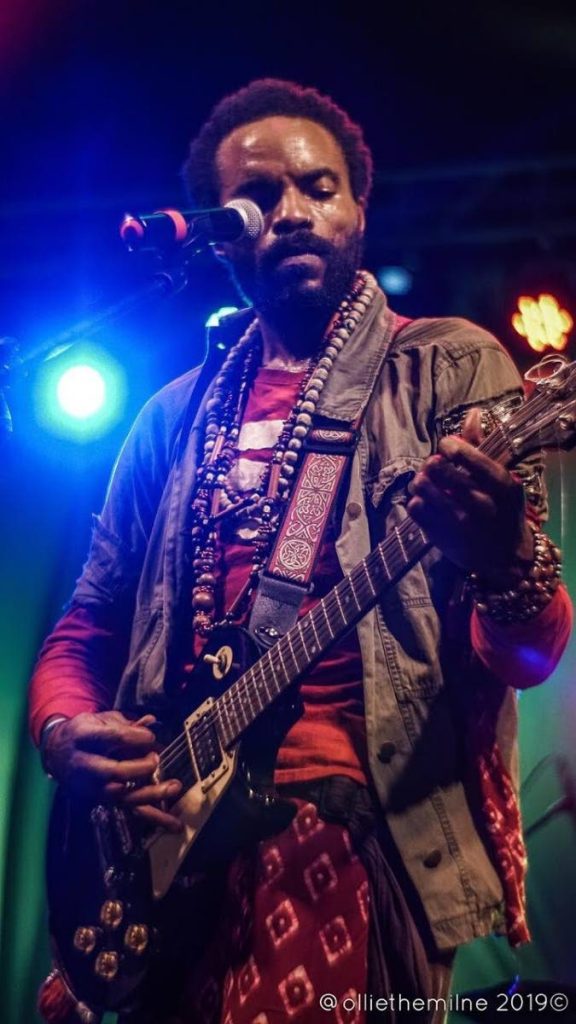
He described central Trinidad as the hub of rock music in the country. His students would go into his art room with their guitars and play during lunch. But in TT and the region, he says rock is seen like “white man devil thing –but people from the Caribbean have been doing their version of rock long before Americans thought they created rock.
“We have been doing this overly theatrical folk expression of self,” he said.
Now he is trying to merge the rock attitude with something more mainstream, yet keeping true to his identity.
“I am Trinidadian. I don’t want to play rock music, meaning, I love the electric guitar, I love the sound of it, I love the over-the-topness of it.
"But I don’t want to be in a rock band. That’s not my intention. I don’t want to play alternative rock, I don’t want to sound like Nirvana, that’s not my intention, to sound like anybody.”
Kaiso punk, kaiso rock and roll, calypso rock and roots, Shango, voodoo, flamenco music – Gyazette's music has been called many different things. Salcedo pulls from many influences such as Marilyn Manson, Korn, Bob Marley, Sparrow, David Bowie, David Rudder, Andre Tanker and Fela Kuti to express the “callaloo music.”
“For years people have been saying, 'write a soca'...As far as I am concerned, I am kinda halfway writing soca. I am doing it in a slightly different way. I don’t know if I want to become a soca artist, that is not my intention. I just want to be Nickolai.”
Salcedo was never formally trained in music, but comes from a musical family. His father, Russel Salcedo, was trained in classical guitar and he is a singer as well. His uncle Keith Salcedo and brother Mikhail are pan arrangers, and his youngest brother Joshua , who plays drums for him, is a multi-instrumentalist.
Now Salcedo plays under his own name, but has the same band members. They are working on expanding their music to pull more instrumentals into their sound.
“We are working to create the super band with all the instruments I always wanted, so I could play around with sound. A bit outside of strictly the edgy rock sound. Because of music and things I’ve been listening to of late, I have been trying to get into West African expressions, that dull guitar sound. I would like to start introducing instrumentals into the set. Just things just to operatically play with the emotions of the audience and take them on a journey when they start to feel like this is something really out of the box.”
Jhinbek: a future history
Filming Hero gave Salcedo a triangular experience of colonisation, where he lived in a country that was created from colonisation, went to a country enriched by colonisation and then a country that became impoverished by colonisation. This inspired him to combine all his talents to tell a story of his own utopia.
“Within recent centuries, I feel as if we are being conditioned to think it is a white-versus-black thing. Then I went to Ghana and I saw the ways in which even in a space where mostly people of the African phenotype, they have their divisions in their society, in tribes or people of different parts of Ghana, and so those things made me come back here and start analysing society.”
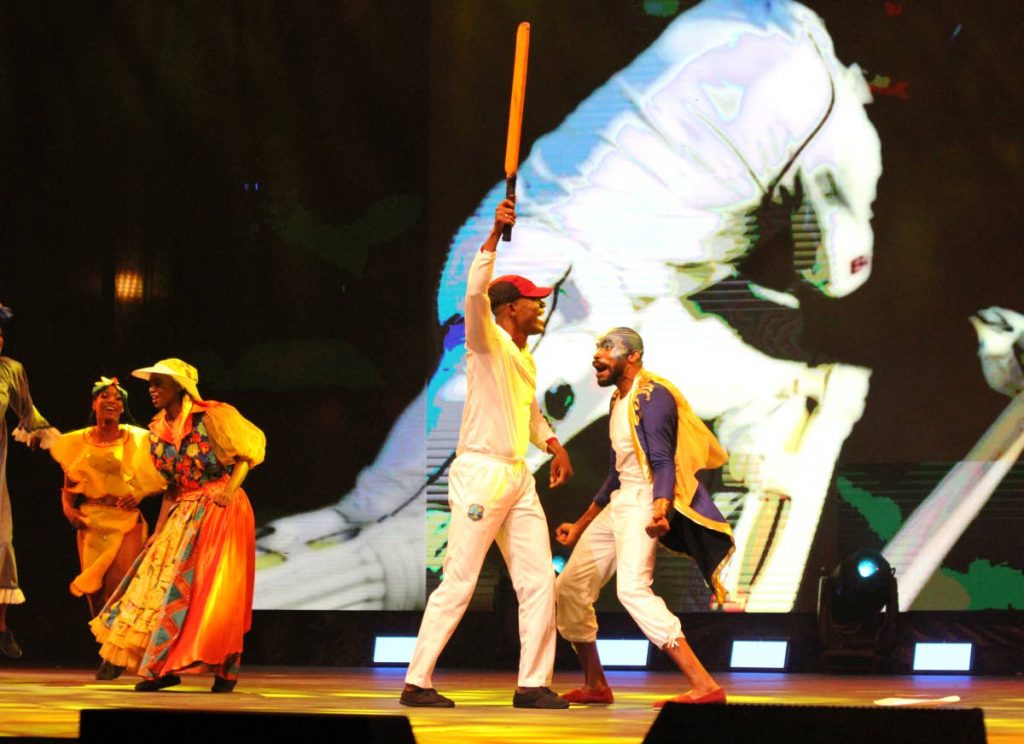
Jhinbek: a Future History is an art exhibition/musical experience that tells the story of a world where TT and Grenada have merged into one country through nano-technology. All the races intermingled, removing racial segregation, and the power structure is matrilinear.
“I felt as though Trinbago has always been in a kind of point to which people from all over the world end up passing. It was the perfect microcosm of the world, so I was using that story to look at what is happening over time if you get isolated and we have to work out the differences we have. How do we work out racism? How do we get rid of sexism?”
In the story, the society is a war culture run by women, who may be war chiefs.
“I feel as if matriarchy and matrilineality are very much primal concepts, it being the way we used to pass things on. We were always sure who our mothers were. I wanted to go back to that.
"It was my way of addressing the imbalances in the world. It’s not that I think women should be running things and men should not be running things, but I just felt as if I just wanted to flip the script and how we could just get rid of the things that plague us and make us hate each other.”
In ThinkArtWork, two paintings from Jhinbek were on display. One, called Khumanh Village, Shugramah, was of naked people walking along the beach. His painting was vividly colourful with calm blue beaches bringing a sense of serenity. Though the bodies are bare, Salcedo says there’s nothing erotic about his work, but people revealing their natural selves.
Salcedo is working on vignettes to accompany each painting to tell the story of his “dystopic/utopia.” The work will not be laid out in chronological order but is meant for the viewer to walk through as if they are archaeologists digging through the future to discover his message.
He is working with his band to develop music for the show, and is hoping to finish the exhibit shortly.
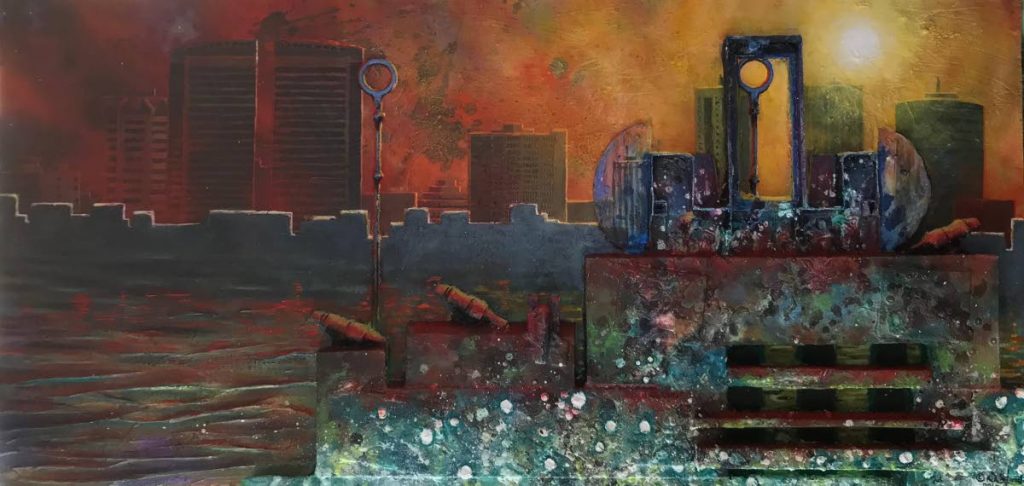
Salcedo's career is multi-faceted for two main reasons. Firstly, he is interested in so many different things.
"I have a semi-short attention span and so for me I know if I am doing art for a while and after that I want to punch through this for two months straight, don’t sleep, don’t eat, don’t do anything else but this, but when that’s done, I would like to move on to something else."
Different artistic expressions also mean different revenue streams. Salcedo sells about four to five of his original paintings yearly, as well as prints. He also gets paid for his various acting and music jobs.
"I do it because I love it, but at the end of the day, I have to eat...To me it is a real blessing that the film industry in Trinidad has at least reached a point where actors get paid and people are not saying, 'Come and do this for free.'"


Comments
"Salcedo’s artistic journey"